This post is part of a larger deep dive
Curious about the role of the illusion of time in The Persistence of Memory? Check out The Persistence of Memory Explained!
Or read the full The Persistence of Memory article!
This post is part of a larger deep dive
Curious about the role of the illusion of time in The Persistence of Memory? Check out The Persistence of Memory Explained!
Or read the full The Persistence of Memory article!
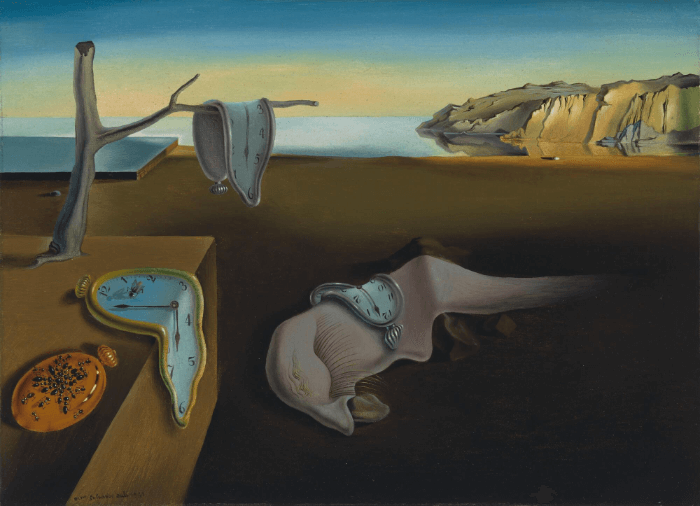
The premise of my analysis below is that all elements in The Persistence of Memory are all somewhat related to time. Let’s consider them one by one.

No doubt that the most intriguing elements of the painting are the melting clocks. I read some interpretations that suggested Dali might have painted the clocks as a sort of homage to Einstein’s Theory of Relativity.
However, that is unlikely to be true, as Dali himself has been on record saying that the soft watches were not inspired by Einstein’s theory, but instead by the surrealist perception of a Camembert melting in the sun.
Still, even though Dali did not make his views on time explicit, it is known that he had a penchant for physics, and was certainly aware of Einstein’s proposal that time isn’t rigid, but rather experienced subjectively.
For that reason, one of the favoured interpretations among art pundits is that the melting clocks represent Dali’s denial that time moves in one single direction, but, in contrast, time as typically defined is nothing but an illusion.
If you read the section on time, this should resonate with you. Some philosophers indeed suggest that the perception of time flowing is an illusion created by our brains. Indeed, the impression that time is passing is simply a consequence of the psychological arrow of time, which allows us to recall past memories but not future ones.
As I explained above, the psychological arrow of time is aligned with the thermodynamic arrow of time, in the sense that we perceive events in a sequence consistent with increasing entropy.
And that’s how I like to think about the melting clocks: as a depiction of increased entropy. The melting clocks in the sun aren’t spontaneously going to reverse to being clocks. Dali added extra dynamism to this scene, because it appears Disorder is hitting them in a way that follows the second law of thermodynamics: entropy of an isolated system always tends to increase.
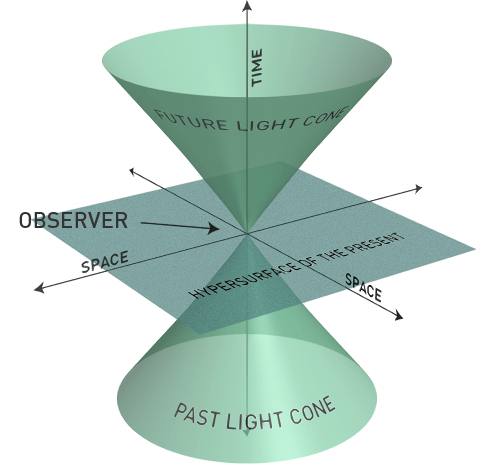
Another way to think about it is that the melting away in the sun is a metaphor for the illusion of time. Time isn’t fixed, but rather malleable, just like the melting clock’s pliable consistency.
Perhaps this is where the idea that The Persistence of Memory is related to the Theory of Relativity comes in. Remember your physics class? Time is relative, my clock on planet Earth will move slower than your clock near a black hole. My clock will tick slower at a jogging pace than your clock when moving at near light speed.
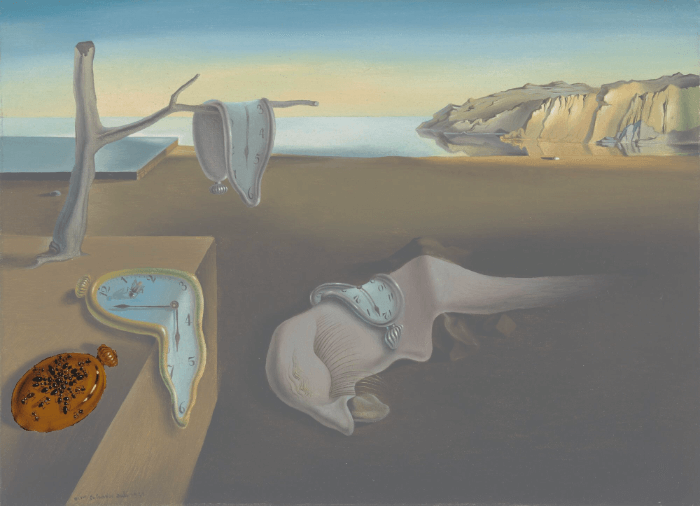
It is interesting that Dali chose to depict ants over a metallic watch. Ants are naturally attracted to decaying organic matter, so this element in the Persistence of Memory is usually understood as representing decay and death.
The fact that the ants are devouring the watch, again, seems to suggest the move towards a more disordered state. Ultimately, everything in the universe will decay. Both the thermodynamic and cosmological and arrows of time ensure that energy and matter gradually become more entropic (disordered) and dispersed over large distances.
This means that decay and subsequent death is inevitable.
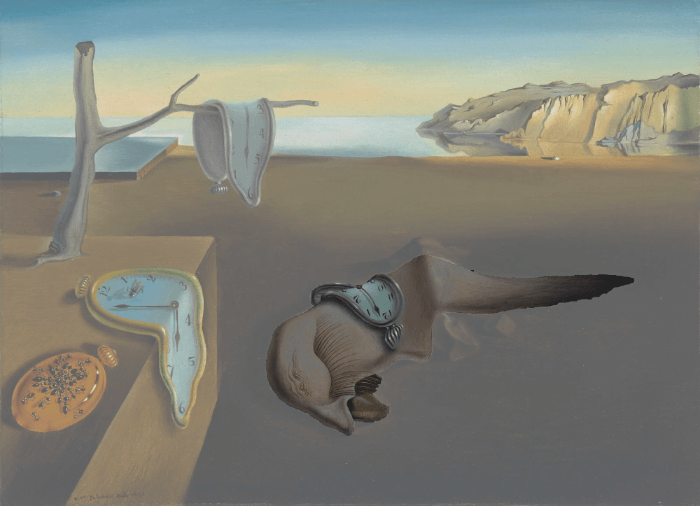
The central figure in The Persistence of Memory has been interpreted as being Dali himself. The figure is distorted, and looks like it is itself melting away.
To me, this suggests that even humans cannot escape the effects of increased entropy. We are not eternal: we grow older, our bodies decay, and we eventually die.
Once again, all I have described above is simply entropy increasing. Our bodies consist of cells, molecules and atoms, which are highly organized into a coherent structure. However, over time, that structure starts to break apart, because, put it bluntly, it simply is a more probable state for our molecules and atoms to be in.
And this is what Dali captured with this disfigured entity: that we are all subjected to the effects of entropy.

By now, the message of the painting should be clear to you.
And another element that appears to corroborate this idea that entropy increases leading to decay and death is the barren landscape.
Note, how the tree seems devoid of life – the trunk has been cut in half, only one branch survived, and there are no leaves or flowers. Similarly, the terrain is uniform with no sign of fauna or flora. The sky is deadly calm, and the sea is almost like a blank canvas.
In other words, the entire landscape gives the impression that time froze. I can imagine stepping into this world and not hearing a single tone, only emptiness.
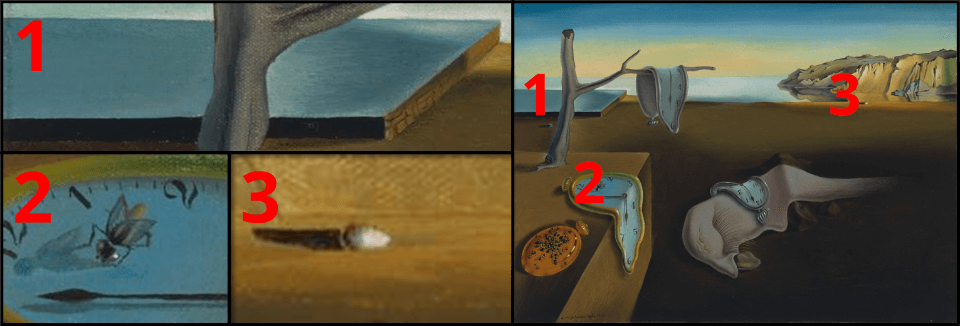
Three additional elements are worth mentioning: the fly on the melting clock on the table; the mirror behind the dead tree; and the egg on the top right near the rocky mountains.
It is possible that Dalí added the fly either as a metaphor for time “flying” or as another symbol of decay, as flies tend to be attracted to rotting organic material as well.
The mirror has often multiple symbolisms. Here, it could symbolise distortion of reality, as it occurs in dreams and memories.
Finally the egg is a recurring motif in Dalí’s works, and it is usually a symbol of rebirth. It is interesting that Dalí chose to add the corpse and devouring ants, both symbols of death, as well as the egg, a symbol of life, on the same setting. This may suggest that life and death exist in a timeless world, where past, present and future are all real and exist simultaneously, an idea not too dissimilar to the Block universe proposal I briefly described above.

There has been some suggestions that the central figure is in a sort of dream state.
One interesting aspect of dreaming is that the perception of time can become distorted in dreams. Some experiments have been conducted in which the experimentor awoke participants who were going through REM sleep (the sleep cycle during which we are more likely to dream) and asked them to estimate how long they believed their dreams lasted. In many cases, participants reported of feeling that their dreams took longer than they actually were.
Even though this result is still up for debate, you might have had this experience yourself. For instance, you might have had a very long conversation with someone and then going out with that someone, taking the train, and arriving at a different place. That would probably take several hours in real life, but we only spend about 90 minutes in REM sleep. In other words, time seemed to be compressed (or sometimes dilated) during dreaming, so we tend to over/underestimate the duration of events in dreams.
The reason I’m mentioning this is because it suggests that, once again, time perception is highly subjective. Time isn’t fixed, and this is especially true in dreams, where time perception changes depending on the content of dreams.
Similarly, memories aren’t facsimiles of actual experienced events. We often confabulate certain elements which weren’t present in the original event, and we might also distort the duration of a recalled event.
Dali may be indirectly pointing out that time perception during dreaming or memory recall are subjective and illusory… persistently so.
Salvador Dalí’s The Persistence of Memory explores the nature of time through surrealist symbolism. The melting clocks, inspired by Camembert cheese, symbolise time’s malleability and the illusion of its linear flow. They also reflect entropy, with their melting representing the irreversible increase of disorder.
Other elements reinforce this theme: ants devouring a metallic watch symbolize decay, the central disfigured figure portrays humanity’s inevitable submission to entropy, and the barren landscape evokes a timeless, lifeless state where entropy has culminated. Contrasting this, the egg, a symbol of rebirth, suggests the coexistence of life and death in a timeless framework, akin to the Block Universe theory, where all moments exist simultaneously.
Dalí also hints at the subjective experience of time. In dreams, time feels distorted, compressed, or stretched, while memories are similarly unreliable, with altered perception of time. The painting invites reflection on time’s illusory and transient nature, shaped by human perception.
Personally, The Persistence of Memory isn’t my favourite work by Dalí. I found it amusing rather than brimming with symbolism which is characteristic of some of Dalí’s most impressive works. Nevertheless, I acknowledge that it fully deserves the spot of the masterwork of surrealistic masterworks.
And to this day, it persists…
Leave a comment
Add Your Recommendations
Popular Tags